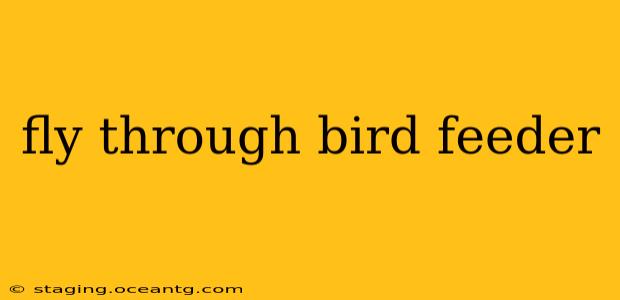Many bird lovers enjoy watching feathered friends flock to their feeders. However, sometimes these cheerful gatherings can turn into unfortunate events when birds collide with the feeder itself. This article explores the reasons why birds might fly into bird feeders, what you can do to prevent collisions, and how to help a bird that has unfortunately suffered an impact.
Why Do Birds Fly into Bird Feeders?
Several factors contribute to birds crashing into bird feeders. Understanding these factors is the first step in preventing these accidents.
Is it always a problem with the feeder's placement or design?
Not always. While poor placement and design are significant contributors, other factors play a role. For instance, a sudden gust of wind can disorient a bird in flight, leading to an unexpected collision. Similarly, a bird might be distracted by a predator or another bird, causing it to lose focus and hit the feeder. Birds also have different levels of spatial awareness, with some species more prone to collisions than others.
What are the common causes of bird feeder collisions?
Common causes include:
- Poor visibility: Feeders placed against a background of similar color or in areas with dense foliage can make them difficult for birds to see, leading to collisions.
- Placement too close to windows or other obstacles: This leaves birds with less room to maneuver during their approach and departure.
- Fast, aggressive birds: Highly competitive species may rush towards the feeder without adequate caution.
- Poor feeder design: Some feeder designs lack sufficient perches or offer limited access points, leading to collisions as birds jostle for space.
- Adverse weather conditions: Strong winds, rain, or snow can disorient birds and impair their vision, increasing the likelihood of collisions.
How can I tell if my bird feeder is causing collisions?
Look for signs like:
- Feathers near the feeder: The presence of feathers around the feeder suggests a recent collision.
- Injured or dead birds: This is the most obvious sign of a problem.
- Birds repeatedly flying into the feeder: If you observe birds repeatedly crashing into the feeder, it's a clear indication of a problem.
Preventing Bird Feeder Collisions: Solutions and Strategies
Preventing collisions requires a proactive approach. Here's how to make your bird feeder safer for its avian visitors:
How can I improve the placement of my bird feeder?
- Increase visibility: Position the feeder in an open area away from trees, bushes, and structures, ensuring good visibility for approaching birds.
- Provide ample space: Place the feeder at least 3-4 feet away from windows, walls, or other obstacles.
- Consider the background: If possible, position the feeder against a contrasting backdrop to enhance visibility.
What type of bird feeder is safest?
There's no single "safest" feeder, but certain designs are less likely to cause collisions:
- Smaller feeders: Smaller feeders accommodate fewer birds at a time, reducing competition and the likelihood of collisions.
- Feeders with multiple perches: This allows birds to feed more comfortably without overcrowding.
- Feeders with clear, unobstructed access points: This makes it easier for birds to approach and depart safely.
What other preventative measures can I take?
- Regularly clean the feeder: A clean feeder reduces the risk of disease transmission, minimizing the attraction of multiple birds to a single area at one time.
- Use appropriate feeder types for different bird species: Choose feeder designs suited to the species you want to attract, minimizing competition.
What to Do If a Bird Hits Your Bird Feeder
If a bird hits your feeder, act quickly and calmly:
- Assess the bird's condition: Check for injuries like broken wings, bleeding, or head trauma.
- Handle the bird gently: If you need to handle the bird, do so with care, using a towel or gloves to protect yourself and minimize stress to the bird.
- Provide temporary shelter: Place the bird in a quiet, dark, and well-ventilated box.
- Contact a wildlife rehabilitator: A wildlife rehabilitator is equipped to provide the appropriate care for injured birds. Do not attempt to treat the bird yourself unless you are a trained professional.
By understanding the causes of bird feeder collisions and implementing preventive measures, you can ensure your feathered friends enjoy a safe and enjoyable dining experience. Remember, responsible bird feeding promotes wildlife conservation and appreciation.
